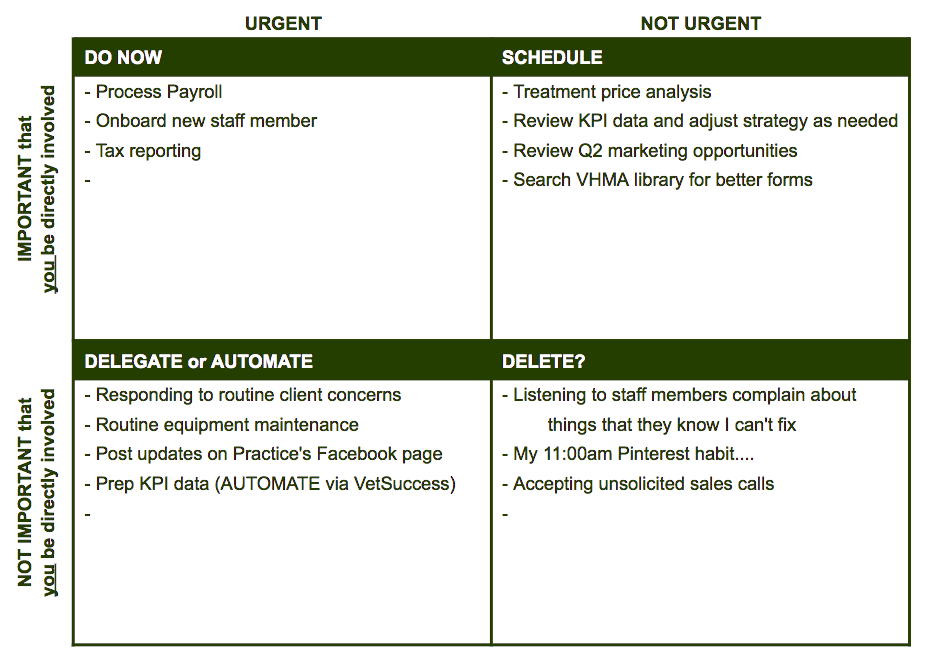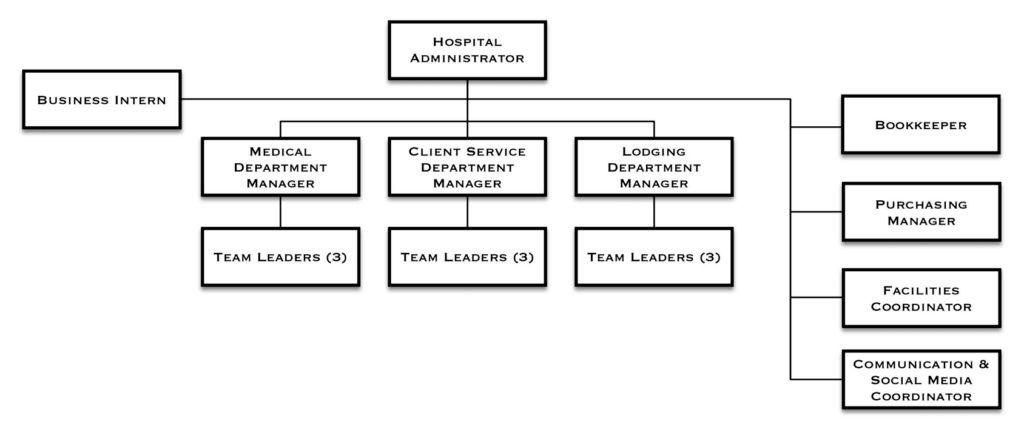In a previous article, Simplify your workload: 4 practical steps for veterinary practice managers, we shared four steps to achieve a more manageable workload. One of the steps is to use the Eisenhower Matrix, a tool that enables you to divide tasks and responsibilities into four quadrants: what to do now, what to schedule, what to delegate or automate, and what to delete.
 Quadrant 3 (delegate or automate) contains tasks that are important but don’t require your direct involvement for effective execution. It’s where the lowest hanging fruit lie and, consequently, where you’ll find the quickest relief from some of the burdens you carry as a practice manager. So how do you go about tackling these?
Quadrant 3 (delegate or automate) contains tasks that are important but don’t require your direct involvement for effective execution. It’s where the lowest hanging fruit lie and, consequently, where you’ll find the quickest relief from some of the burdens you carry as a practice manager. So how do you go about tackling these?
Step 1: Set priorities
Before delegating tasks, rank them in order of priority. Working through each item in Quadrant 3, ask yourself these questions:
How much time will I save by delegating this task? Is this something that only takes a few minutes to complete, or is it something that eats up 30 minutes of your time? When it comes to delegation, the more time-consuming the task, the higher it should rank on your priority list.
How frequently does the task occur? Is this a one-off task or something that must be completed frequently? Given the time and energy it requires to effectively delegate a task, your time is best spent delegating those that occur often. Only once you’ve delegated tasks that occur frequently should you begin delegating the one-offs.
What will happen if my delegate fails to complete the task effectively? If a report is run incorrectly, it’s probably not the end of the world; you can simply run it again. If a payroll deadline is missed, however, that’s a different story. Consider what the worst-case scenario will be if a task is not completed successfully. Begin by delegating those that pose the fewest consequences in the event of failure.
How do I feel about completing this task? Tasks that pose a definite disruption to your day and productivity should trump those that are simply annoying or unpleasant.
Step 2: Decide which method of delegation to use
Depending on the task, the most effective method of delegation may differ. Here are three types to consider.
Empower your team
By setting up a framework that empowers staff to solve general practice issues without intervention (for example, creating detailed guidelines on how to address client complaints or a process for mediating conflict among staff members) you’ll spend less time putting out fires and more time being productive. To empower your team effectively:
Establish a troubleshooting budget: If a problem can be resolved for $25 or less, empower frontline staff to resolve it without requesting permission. For managers, you might want to up the budget to $100.
Provide guidelines and coaching: If, say, a client calls to express frustration about an interaction at the practice and it appears the practice is at fault, coach your team to offer a credit toward that client’s next visit instead of a partial refund. This way, the client is more likely to return, giving your practice the opportunity to redeem itself.
Give feedback: Be truthful yet tactful. For example: “Thank you for handling that situation with Mrs. Smith. Next time, let’s comp one of Max’s days in daycare instead of giving Mrs. Smith a complimentary bag of dog food as this will cost the practice less.” Keep in mind that you and your team will have to navigate a substantial learning curve, so be patient. Staff members are bound to make mistakes, but it’s imperative they don’t become afraid of being empowered. Encourage them to use their best judgment (within certain established parameters, of course) and coach them constructively and tactfully. Over time, their decisions and actions will mirror your own more and more.
Delegate to a specific team or individual
Some tasks within Quadrant 3 will need to be delegated to an individual staff member or team. To ensure follow-through:
Keep a running checklist: Keep track of tasks delegated, tasks in progress, and tasks completed to ensure nothing slips through the cracks.
Promote accountability: Project management tools like Asana and Basecamp are easy, effective ways to keep your team accountable and avoid oversights, especially for recurring tasks.
Be consistent with follow-up: Without micromanaging, make sure your team is aware that you’re monitoring progress and checking in to see if and how delegated tasks are being completed. Fail to do this and your staff will become less motivated to fulfill the responsibilities you’ve assigned to them.
Create new roles and opportunities for advancement
 If Quadrant 3 is filled to the brim, it may be time to examine the structure of your practice. What does your existing leadership team look like? How much is your practice spending on management compensation, and is there room to invest more?
If Quadrant 3 is filled to the brim, it may be time to examine the structure of your practice. What does your existing leadership team look like? How much is your practice spending on management compensation, and is there room to invest more?
Consider how you might modify your organization’s structure to redistribute tasks and responsibilities. Ultimately, your organizational structure will depend on the size of your practice and, of course, your practice’s financial health. Here’s an example of how leadership responsibilities could be distributed throughout a practice. (Please note, this org chart example focuses only on the business side of things and doesn’t include medically oriented roles like a medical director.)
Step 3: Get set for success
Whether you choose to empower your team, delegate tasks to specific individuals or teams, or establish new practice roles and opportunities for advancement, use these four keys to success:
Think before you delegate: To ensure the task warrants delegating, refer to the four questions listed in Step 1.
Establish a mutual understanding: Make sure that your team’s understanding of the delegated task aligns with your expectations.
Obtain a firm commitment: Don’t just assign and assume. Whether you’re delegating to a team or an individual, have those responsible for the task confirm their commitment.
Promote accountability: This is perhaps the most important key to success. Ongoing two-way communication and regular check-ins are non-negotiable.
Remember, delegation represents just one of the four Eisenhower Matrix quadrants. To manage your workload more effectively and bring greater value to your practice, learn more about the remaining three quadrants.



